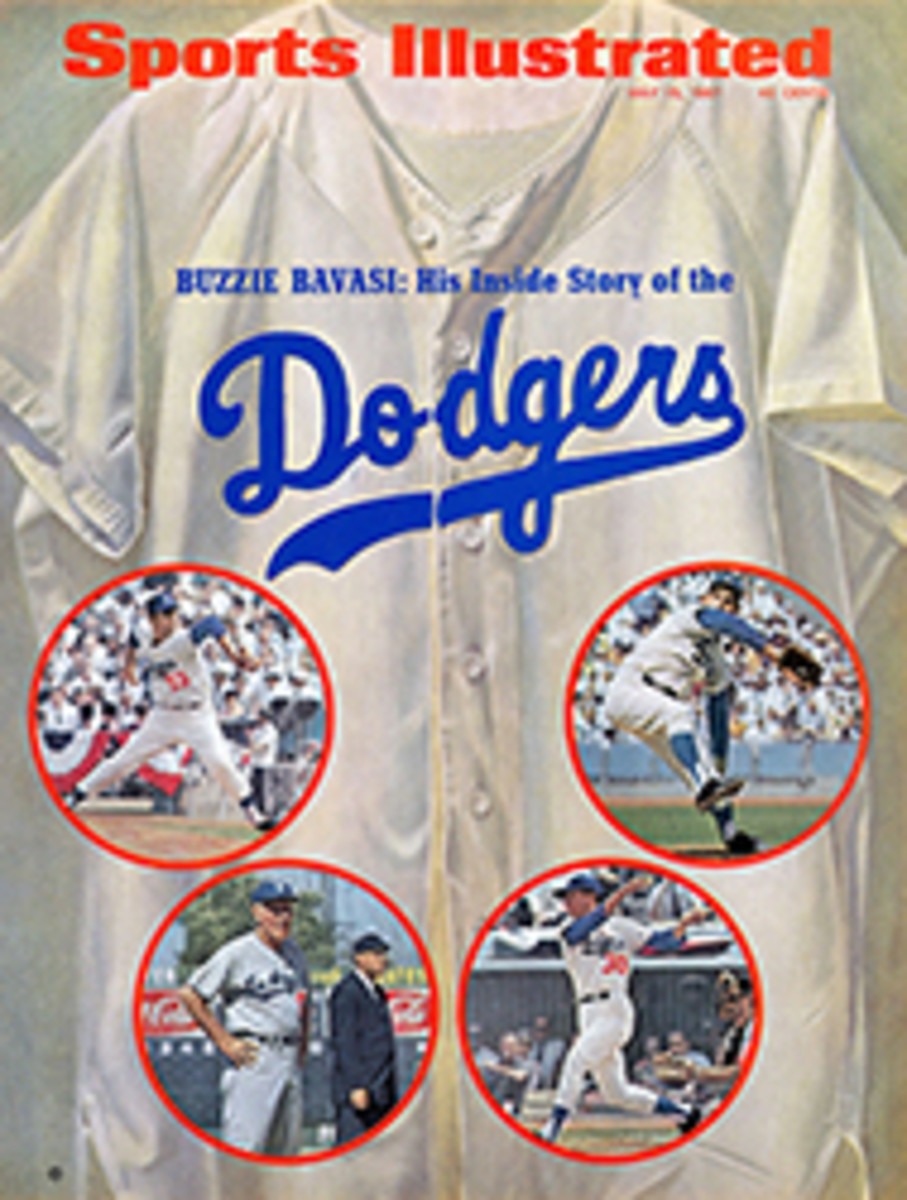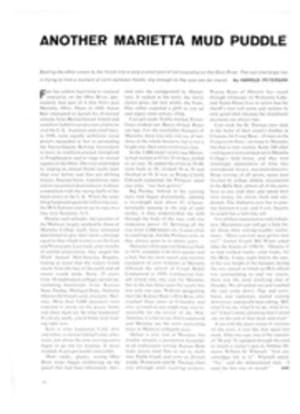
SOME OLD GRADS GET A HAZING
Things were much the same at Notre Dame last week. The weather was awful, and everything looked gray and tired except the football team, which knows better. Terry Hanratty's hair was combed a little longer in front, the better to protect his advancing forehead, he said. Underneath he is still the same shy, humble, modest, prudent, cow-eyed quarterback opponents learned to dread the sight of last fall. He still throws the football with greater accuracy and more revolutions-per-minute than anybody Ara Parseghian ever coached. "You ought to catch him sometime," said Ara on the morning of the Oldtimers game. "You ought to go out and let him throw you a couple. No wasted movement, no wobbles, real tight. Plenty of rpms. And he doesn't have to wind up. He's like Namath. He comes back here to the ear and wham! a shot."
Coley O'Brien, the best second quarterback in college football, was still on his 5,000-calories-a-day diabetic's diet, gulping orange juice and chocolate bars. Chocolate bars? Yes. Chocolate bars, he said. Diabetes is a more attractive disease than it used to be. While he is working to beat Hanratty out of a job, Coley continues to win friends with his midshipman's manners and his resourcefulness. People do not realize how good Coley O'Brien is (he being only No. 2) until they look again at the film of the 10-10 tie with Michigan State and see that insulinized little body rallying the Irish in the second half.
Jim Seymour, the sophomore end who caught all those passes and made (with Hanratty) all those magazine covers last fall, has added to his self-assurance, which was already considerable. Seymour is doing a regular week-night radio show on WSND. He sometimes doubles as a disc jockey. He admits he is getting good at it. He is not likely to pass from natural self-assuredness to cocky self-possession, however, because while he was on the bench tending a bruised shoulder last Saturday Hanratty and O'Brien found a couple of other guys who can catch a football—Paul Snow and Dan Harshman—and they each caught six passes, sometimes spectacularly. The anticipated rout of the oldtimers was undiminished by Seymour's absence.
The score of the annual spring game was 39-0, but that is unimportant. Important is what should have been obvious to rival coaches who were hoping to see otherwise: success has not spoiled Notre Dame's young stars. Notre Dame is here to stay another year, perhaps two or three, unless the bad recruiting season they are now having catches up with them. For those who mourn the graduation of such names as Conjar, Eddy, Page and Lynch, here are just a few new ones to remember: Jockisch, Ziznewski, Gladieux, Racanelli and Kuechenberg, if you can—or try Konieczny, Kuzmicz or Vuillemin. Just try.
The Oldtimers game was a brainstorm of Knute Rockne. It has been played every year but two since 1929 as a service to Notre Dame nostalgics. It does not, unfortunately, do what it was cut out to do—provide the varsity with some revealing competition at the conclusion of spring practice. The varsity reveals very little. Neither does it provide much nostalgia, because the oldtimers are mostly not old. They are seniors fresh off the previous varsity (e.g., Eddy, Conjar, Lynch) and a large detachment of scrubs on loan from the incumbent varsity.
Former Irish luminaries are brought in to dress up the show, but they have usually become goodtimers with midriff bulge, and when they make an appearance it is brief. They try to keep out of harm's way. The professional players who show up are those of modest achievement; if they were not, the pro team would not let them risk injury.
The oldtimers have been coached since 1946 by Bill Earley, a former assistant to Frank Leahy who went on to a richer life selling cardboard in South Bend. Earley is a round-faced man with a voice that roars across a crowded room. He gets a kick out of the game and has the high humor to appreciate his position.
Earley is a regular at the Knights of Columbus lodge, and on the week of the game he can be found there and other places watching for a familiar face or an able body. "Oh, is Pietrosante in town? Tell him I'm looking for him, will you?" Earley is considered an amazing coach because his teams have won four of the 22 games since 1945. Each time his team won, he said, he had worked a proven formula: a heavy contingent of graduating seniors and a quarterback worthy of the name. His four winners were Johnny Lujack, John Mazur, Bob Williams and Ralph Guglielmi.
Earley's window dressing this year was to include Leon Hart, the big end who starred for Leahy's national champions in 1949 and then for the Detroit Lions. Hart had a business commitment. Nick Pietrosante, the fullback of the Browns, was in town the night before the game but had to leave again. Halfback Johnny Lattner, his hair now silver, got in for one poor punt. Red Mack of the Packers played more than any of the legitimate oldtimers and caught four passes. Tackle Gus Cifelli made his 18th straight appearance a brief one.
Earley says it gets tougher to put together a team every year, and Parseghian admits there will have to be a change in the format. Notre Dame alumni are spread out all over the country, and there is no travel budget. Those who come in for the game usually arrive on Thursday, and Earley figures if all goes well he will have one day, Friday, to practice. On Thursday night he consorts with a group of Ara's assistants at Eddie's, and they rib him about running up to the press box to hide before the game was over in 1965, when the final score was 72-0.
What saves the game, of course, are the seniors and the varsity scrubs, because they know all the plays and are in shape. Also there are a few ground rules laid down to neutralize the aggressiveness of Assistant Coach John Ray's varsity defense, to wit, no red-dogging.
"We cannot," said Earley to Ray on Thursday night, "afford to let you kill one of our alumni quarterbacks. It would not look good in the papers."
Last year, Earley said, Ray could not control himself. "I looked up and there were his linebackers, pouring in on our helpless quarterback. Red-dogging."
Earley ran around the field and braced Ray on the varsity sidelines.
"You're red-dogging."
"No we're not, we're just wiping off [linebackers reacting quickly to the ball-carriers]. Go back on the other side where you belong. Besides, you're red-dogging."
"Nobody said we couldn't red-dog."
Last year Earley got Coley O'Brien for a few plays, out of the goodness of Ara Parseghian's heart. Coley took the old-timers on a 60-yard drive downfield.
The next thing Earley knew the student manager was at his elbow. "What do you want?" Earley asked him.
"O'Brien," he said.
"You can't have O'Brien."
"Ara wants him back."
Goodby, O'Brien.
The game this year took on a new dimension: it was nationally televised by ABC-TV in competition with the Kentucky Derby on another network. Beano Cook, the megaphone behind the voices of ABC, stood up in the press box when Ray's defensive line—which compares in size to the Los Angeles Rams's—smothered a play and announced grandly, "There are more horses here than there are at the Kentucky Derby. ABC has done it again."
Parseghian, meanwhile, experienced an unusually relaxed week, for him. He looked healthy. He was well-tanned. He played some golf. He smiled through appointments and interviews. He said he had cut down drastically on speaking engagements and appearances, and after the heavy mid-winter snow he had taken his wife to Hawaii where they had relaxed on the white beaches for nine days. He said he had needed it. Ara is a gung-ho man who does not enter a conversation that he does not speed up. He is capable of some terrific needling if he likes you, and he may even teach you how to putt whether you want him to or not (he plays golf to a four handicap), but he is not an extrovert like, say, the irrepressible Coach Ray, his right arm. Ara has to push himself. If he could be Notre Dame's head coach and No. 1 in the polls without ever answering another question he would like it fine, but he accepts the responsibility with what might be called an intense resignation, knowing it is part of the job.
He has finally come to realize, too, that in the superaccentuated world of Notre Dame football, he cannot please everyone no matter how hard he tries. To facilitate telephone interviews, his publicist, Roger Valdiserri, put Ara's answers to stock questions on tape so that he would not have to answer the same question 4,000 times. "And would you believe it?" says Parseghian. "A radio guy in St. Louis rapped me."
Ara says he finally got over the criticism of "going for the tie" in the 10-10 game with Michigan State, knowing that within himself and among his staff he had done the right thing and wishing in a way that he could invite each critic into his office and explain the circumstances and what went on in his mind and on the sidelines in those final hectic moments. He thinks then they would realize that he had made the correct decision. He also said he had received only three ties for Christmas.
The one thing bothering Ara now is his recruiting program. It has been the leanest year for signing high school boys to play at Notre Dame since Parseghian arrived four years ago. "It was a gradual realization," he said. "Suddenly we woke up in April and realized we hadn't signed many of the boys we were really after. Some of them we were after for two years. Concerned? You're damn right I was concerned. I was alarmed." You can hear those teardrops falling in East Lansing.
If the Notre Dame recruiting is truly bad, it will not show up for two years or more, and it is always possible that Parseghian will be able to recoup next year. Besides, he says, you never know how they're going to turn out. "When I first saw Hanratty and that little O'Brien, I thought, 'Oh, no, what are we getting ourselves in for?" It didn't take lone to find out."
PHOTO
In an unusual scene, Ara Parseghian shares a smile with an "opponent"—old grad Jim Lynch.

